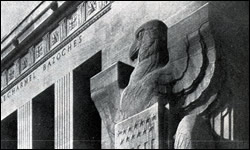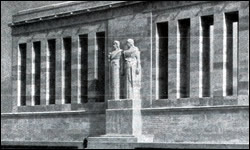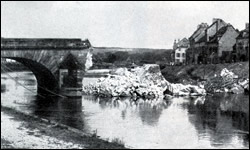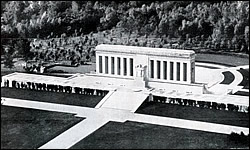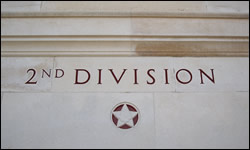
| Home | About |
Aisne Marne American Memorial |
|
| Chateau-Thierry American Monument Dedication in 1937 | |
This impressive memorial was erected by the United States Government to commemorate the American fighting in the Aisne-Marne region and the friendship and cooperation of the French and American forces during the war. The two sculptured figures at the center of the colonnade are symbolic of France and the United States. The names inscribed above the columns are those of places where important American fighting occurred. Inside the colonnade at the closed ends are marble tablets upcn which appear inscriptions giving a brief resume of all of the American fighting in this general vicinity. From the terrace of the monument, a wonderful view of the Marne River valley is obtained. On this terrace is located an orientation table giving distances and directions to various places and above it is an ornamental map of the region showing the ground gained by American troops on July 18 and thereafter. Along the walls on each side of the map are carved the names and wartime insignia of the corps and divisions whose services are commemorated at this place. Jean de la Fontaine, who was born in Chateau-Thierry, is said to have written a number of his fables on this hill. Napoleon, just prior to the battle of Montmirail, camped his army in this neighborhood. The old main highway to Paris passed through this spot. The following description of the American fighting in this vicinity has been written to be read while on the main terrace of the monument. The large town which is seen about a mile away, located on both sides of the Marne River, is Chateau-Thierry. Face its tall, square church tower, which direction is approximately east. Just beyond and to the left of the church are the tree-covered ruins of the old chateau which gave the town its name. During the critical days of late May 1918, when the German troops were advancing rapidly in this direction, the American 3d Division was training in an area some distance to the southeast of here. As the hostile rush continued and the gravity of the situation became more apparent, this division, which had had no front-line experience, was hurriedly moved up and thrown into the line in scattered detachments near ChateauThierry, to assist in preventing the Germans from crossing the Marne River. The 7th Machine Gun Battalion of that division arrived late in the evening of May 31, about the time the German troops were entering the northern (left) outskirts of Chateau-Thierry, and took up a position along the south (right as seen from here) bank of the river to defend the crossings in town. Two guns of that unit were sent to assist French detachments fighting just beyond the chateau and, though orders for their withdrawal had been issued, they were still there when during the night of June 1 the highway bridge was blown up by the French to prevent the Germans from crossing. Arriving at the bridge just after it had been destroyed, the men who had manned these two machine guns resolutely fought their way to the railroad bridge where they and their French comrades, after a hand-to-hand conflict with German infantry, succeeded in recrossing. This machine gun battalion of the 3d Division, assisted by French troops, prevented the Germans from crossing the river in town and inflicted exceptionally heavy losses on them. It was due to this spirited defense, to the gallant stand of the 2d Division in the area just visited and to the desperate efforts of the French units that the German advance on this front was definitely stopped on June 4. The hostile front line at that time did not cross the Marne River but did include all of this hill. On June 6 and 7 the French 10th Colonial Division with the 30th Infantry of the 3d Division attached, starting about 1 1/2 miles to the right of here, launched two attacks against this hill and succeeded in gaining a foothold on top of it. The 4th Infantry, 3d Division, later in June, held a front-line position in the wood behind here for a few days. The 3d Division held the south bank of the river from Chateau-Thierry on as far as the eye can see during part of June and July, the German lines being on the other bank. Its activities until July 15 consisted mainly in preparing its own position for defense and in sending an occasional patrol across the river to capture prisoners and attempt to secure information concerning the enemy troops. On July 1 small units of the 111th Infantry, 28th Division, and on July 6 elements of the 111th and 112th Infantry Regiments, 28th Division, assisted the French in local attacks which gained some ground in front of here. On July 6 the small wood, Bois de Courteau, seen directly ahead on this slope, was captured. On the night of July 8-9, the Germans recaptured that wood in an attack during the course of which four companies of the 28th Division became engaged. As a result of the French-American counteroffensive which began on July 18 south of Soissons, the Germans withdrew from this vicinity during the night of July 20-21. They were immediately pursued by the troops on this front. |
|
|
| Last Update: 01/05/2025 1:21 AM | Web site founded 2002. | ©1917-2025 2nd Division (Regular) A.E.F. |
